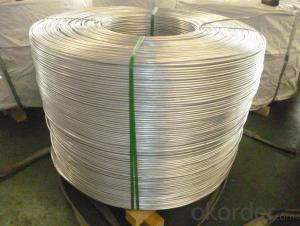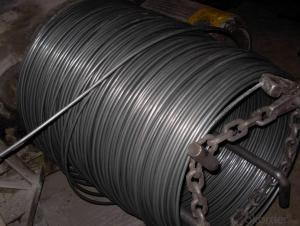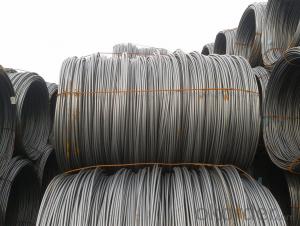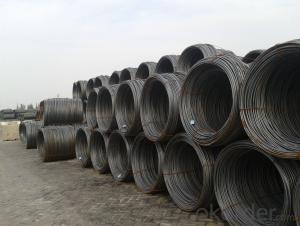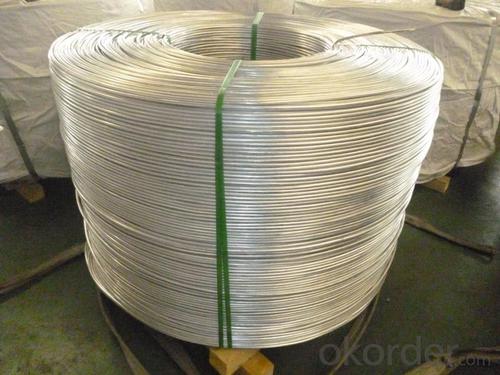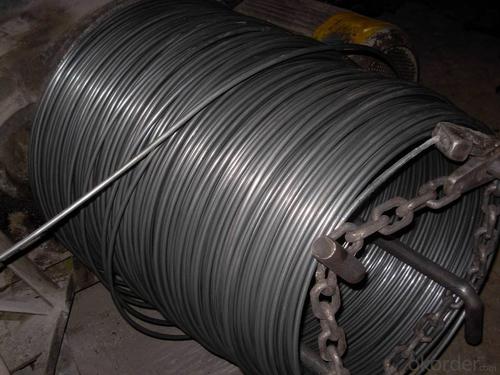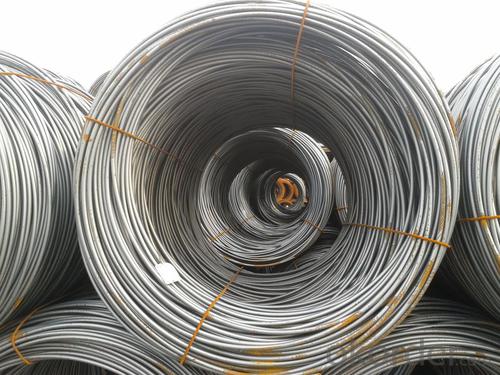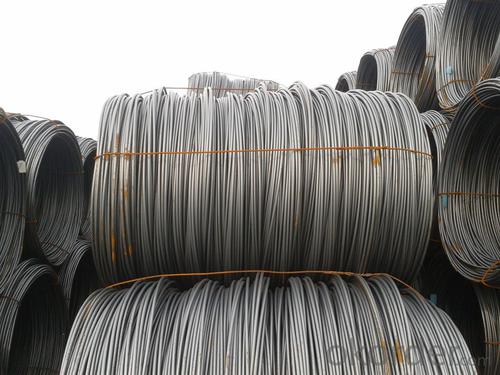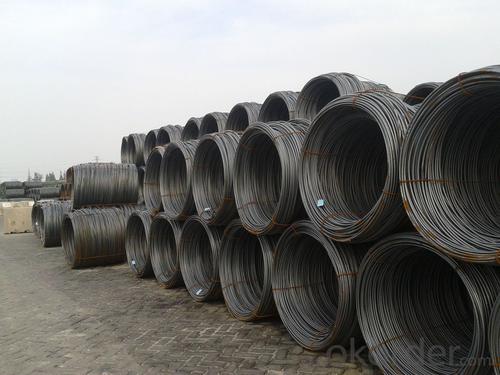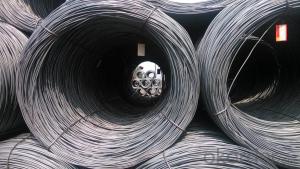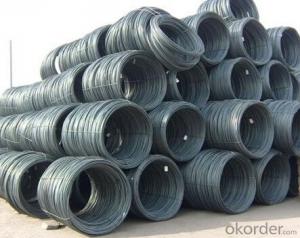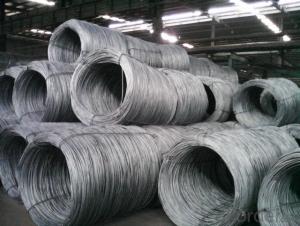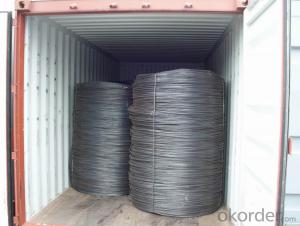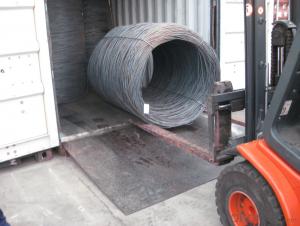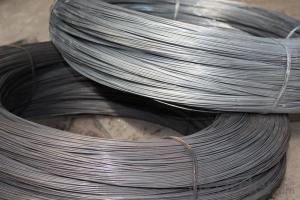SAE1006Cr Carbon Steel Wire Rod 12mm for Welding
- Loading Port:
- Shanghai
- Payment Terms:
- TT OR LC
- Min Order Qty:
- 100 m.t
- Supply Capability:
- 30000 m.t/month
OKorder Service Pledge
OKorder Financial Service
You Might Also Like
Specification
Description of SAE1006Cr Carbon Steel Wire Rod 12mm for Welding:
OKorder is offering Color Coated Steel Coil Prepainted Steel Coil at great prices with worldwide shipping. Our supplier is a world-class manufacturer of steel, with our products utilized the world over. OKorder annually supplies products to European, North American and Asian markets. We provide quotations within 24 hours of receiving an inquiry and guarantee competitive prices.
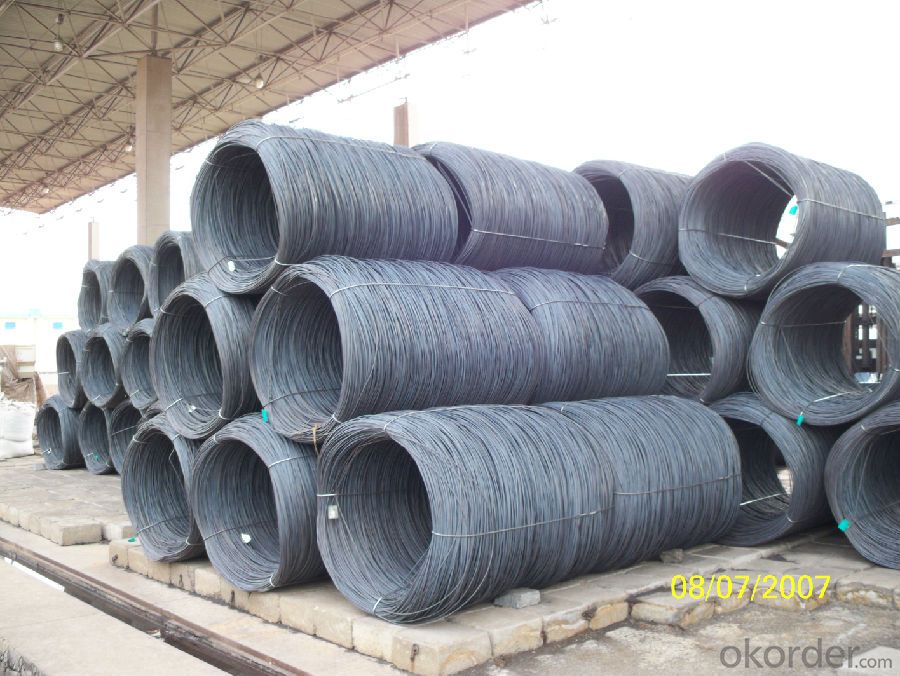
Applications of SAE1006Cr Carbon Steel Wire Rod 12mm for Welding:
Color Coated Steel Coil Prepainted Steel Coil are ideal for structural applications and are widely used in the construction of buildings and bridges, and the manufacturing, petrochemical, and transportation industries.
Main Product Features of SAE1006Cr Carbon Steel Wire Rod 12mm for Welding:
· Premium quality
· Prompt delivery & seaworthy packing (30 days after receiving deposit)
· Corrosion resistance
· Can be recycled and reused
· Mill test certification
· Professional Service
· Competitive pricing
Specifications of SAE1006Cr Carbon Steel Wire Rod 12mm for Welding:
1, Introduction: Color coated steel coils(sheets), i. E. PPGI, also called prepainted steel coils(sheets), are made of galvanized steel coils(sheets) with polymer coatings as surface. It's a new enclosure material and building board with characteristics of light-weighted, heat preserved&insulated, easily installed with bright colors.
2, Production Process: Pretreatment(Degreasing)_Drying_Chromating_Paint Basic Oil_Cooling_Drying_Color Coating_Cooling_Film-covering_Rolling Up
3, Characteristics:
Good at corrosion resistence. Besides zinc coating of the basic plate of galvanized steel sheet, the color coating as the surface has double lifetime to ensure better anticorrosion effect.
With excellent cold bending molded manufacturablity, PPGI products can be processed or directly used as final product. As being light-weighted and conveniently transported, they're widly used to replace wood to save energy.
4.There're thousands of colors can be chosen as per different application. Any color plays well in decoration.
No pollution with high recycling rate, PPGI coils and sheets are strongly recommended as enviroment-friendly products by the government.
5, eye bands and 4 circumferential bands in steel, galvanized metal fluted rings on inner and outer edges, galvanized.
| commodity | SAE1006Cr Carbon Steel Wire Rod 12mm for Welding |
| Techinical Standard: | JIS G3302-1998, EN10142/10137, ASTM A755 |
| grade | Q195,Q215,Q235,SAE1006,SAE1008 SAE1006Cr |
| Types: | Mesh welding |
| Base metal | galvanized, galvalume, cold rolled steel |
| Thickness | 0.14-1.0mm(0.16-0.8mm is the most advantage thickness) |
| Width | 610/724/820/914/1000/1200/1219/1220/1250mm |
| Type of coating: | PE, SMP, PVDF |
| Zinc coating | Z60-150g/m2 or AZ40-100g/m2 |
| Top painting: | 5 mic. Primer + 15 mc. R. M. P. |
| Back painting: | 5-7 mic. EP |
| Color: | According to RAL standard |
| ID coil | 508mm610mm |
| Coil weight: | 2--3MT |
| Package: | Properly packed for ocean freight exportation in 20'containers |
| Application: | Industrial panels, roofing and siding for painting/automobile |
| Price terms | FOB, CFR, CIF |
| Payment terms | 20%TT in advance+80% TT or irrevocable 80%L/C at sight |
| delivery time | 25 days after recepit of 20% TT |
| Remarks | Insurance is all risks |
| MTC 3.1 will be handed on with shipping documents | |
| We accept SGS certificatation test |
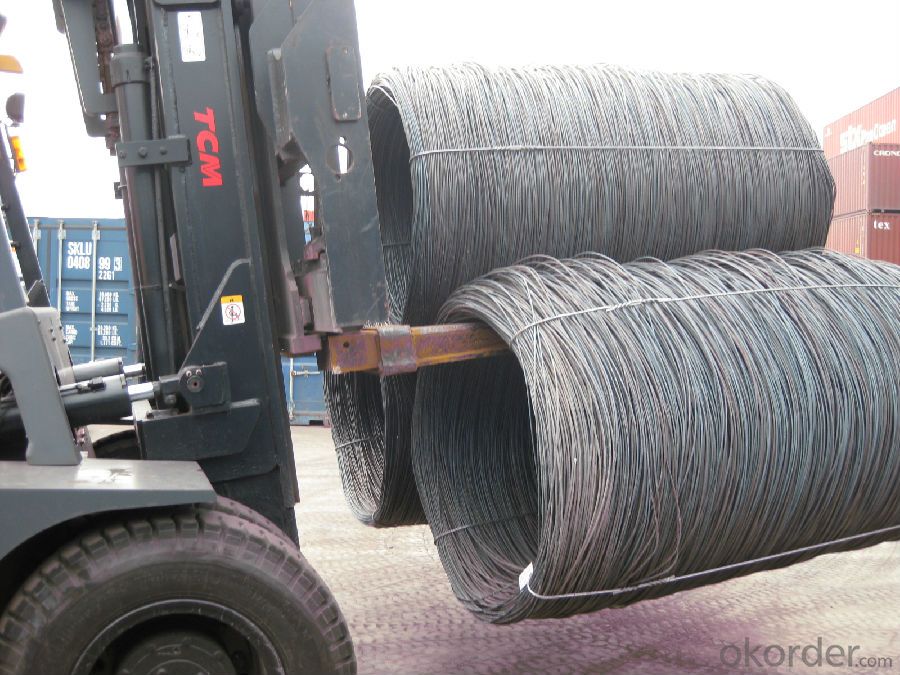
FAQ of SAE1006Cr Carbon Steel Wire Rod 12mm for Welding:
Q1: Why buy Materials & Equipment from OKorder.com?
A1: All products offered byOKorder.com are carefully selected from China's most reliable manufacturing enterprises. Through its ISO certifications, OKorder.com adheres to the highest standards and a commitment to supply chain safety and customer satisfaction.
Q2: How do we guarantee the quality of our products?
A2: We have established an advanced quality management system which conducts strict quality tests at every step, from raw materials to the final product. At the same time, we provide extensive follow-up service assurances as required.
Q3: How soon can we receive the product after purchase?
A3: Within three days of placing an order, we will begin production. The specific shipping date is dependent upon international and government factors, but is typically 7 to 10 workdays.
Q4: What makes stainless steel stainless?
A4: Stainless steel must contain at least 10.5 % chromium. It is this element that reacts with the oxygen in the air to form a complex chrome-oxide surface layer that is invisible but strong enough to prevent further oxygen from "staining" (rusting) the surface. Higher levels of chromium and the addition of other alloying elements such as nickel and molybdenum enhance this surface layer and improve the corrosion resistance of the stainless material.
Q5: Can stainless steel rust?
A5: Stainless does not "rust" as you think of regular steel rusting with a red oxide on the surface that flakes off. If you see red rust it is probably due to some iron particles that have contaminated the surface of the stainless steel and it is these iron particles that are rusting. Look at the source of the rusting and see if you can remove it from the surface.
- Q: How is steel wire rod used in the production of nails and screws?
- Steel wire rod is commonly used in the production of nails and screws as it serves as the primary material for manufacturing these fasteners. The wire rod is first heated and then drawn into the desired diameter to form a continuous wire. This wire is subsequently cut into specific lengths and shaped into nails or screws through a series of processes, including heading, threading, and pointing. The high strength and durability of steel wire rods make them ideal for creating strong and reliable nails and screws that can withstand various applications and securely hold materials together.
- Q: What are the common standards for steel wire rod?
- Steel wire rod standards differ depending on the industry and specific use. However, the steel wire rod manufacturing industry generally adheres to several well-known standards. One widely accepted standard is the ASTM standard, specifically ASTM A510/A510M. This standard provides general requirements for carbon and alloy steel wire rods and coarse round wire. It covers aspects such as chemical composition, mechanical properties, dimensions, and tolerances. Another common standard is the ISO standard, specifically ISO 16120-2. This standard outlines the general requirements for non-alloy steel wire rod intended for conversion into wire. It includes details on chemical composition, mechanical properties, and dimensions. Additionally, industry-specific standards exist for steel wire rod. For instance, the automotive industry follows its own set of standards to ensure the quality and performance of steel wire rods used in automotive applications. In summary, common standards for steel wire rod include ASTM A510/A510M, ISO 16120-2, and industry-specific standards. These standards guarantee that steel wire rods meet the necessary requirements for their intended uses and promote consistency and quality during the manufacturing process.
- Q: What are the different types of steel wire rod?
- There are several different types of steel wire rods, including low carbon, medium carbon, high carbon, alloy, and stainless steel wire rods.
- Q: How is steel wire rod used in the manufacturing of wire for musical instrument strings?
- Steel wire rod is an essential component in the manufacturing of wire for musical instrument strings. It serves as the raw material that undergoes a series of processes to transform it into the high-quality wire used in guitar, piano, violin, and other instrument strings. To begin with, steel wire rod is typically made from carbon steel, which is known for its strength and durability. This makes it an ideal material for producing wire that can withstand the tension and stress exerted on musical instrument strings during playing. The manufacturing process starts with the steel wire rod being heated and then rolled into thinner strands through a process called drawing. This drawing process helps to refine the steel wire rod by elongating and thinning it, resulting in a more uniform and consistent diameter. Once the wire has been drawn to the desired thickness, it undergoes a series of heat treatments to improve its mechanical properties. This includes processes such as annealing, which helps to relieve stress and enhance the wire's flexibility and elasticity. After the heat treatments, the steel wire is further processed to achieve the desired characteristics for musical instrument strings. This can involve additional drawing steps to achieve the desired gauge or diameter, as different instruments require specific string thicknesses for optimal sound production. Furthermore, the wire can be coated with various materials to enhance its performance and longevity. For instance, a thin layer of nickel or stainless steel may be applied to improve corrosion resistance and provide a smoother surface for playing. Finally, the wire is wound onto spools, ready to be used by manufacturers of musical instrument strings. These strings are then carefully crafted and assembled, incorporating the steel wire as the core material that carries the tension and produces the desired pitch and tone when played. In summary, steel wire rod is a critical material used in the manufacturing of wire for musical instrument strings. Through various processes such as drawing, heat treatments, and coating, the steel wire rod is transformed into high-quality wire that meets the specific requirements of different instruments. The resulting strings provide musicians with the necessary strength, flexibility, and tonal characteristics to create beautiful music.
- Q: How is steel wire rod used in the manufacturing of wire cables?
- Steel wire rod is used as a raw material in the manufacturing of wire cables. The wire rod is typically drawn through a series of dies to reduce its diameter and increase its length, resulting in a thinner and longer wire. This wire is then twisted or braided together to form strands, which are further twisted or braided to create a sturdy and flexible wire cable. Steel wire rod provides the necessary strength and durability required for wire cables to support heavy loads and withstand various applications such as in construction, transportation, and electrical industries.
- Q: How is steel wire rod used in the manufacturing of wire for elevator door systems?
- The manufacturing of wire for elevator door systems heavily relies on steel wire rod. For elevator doors to function properly, they need wires that are strong, durable, and capable of enduring constant use and frequent opening and closing. Steel wire rod, derived from steel billets and serving as a semi-finished product, is the primary raw material utilized in wire production. To initiate the process, steel wire rod goes through various mechanical and heat treatments to enhance its strength and flexibility. These treatments, such as hot rolling, drawing, and annealing, refine the wire's structure and enhance its mechanical properties. The objective is to ensure that the resulting wire can withstand the tensions and stresses encountered during elevator door operations. Once the wire rod has undergone processing, it is further drawn and shaped to meet the desired dimensions and specifications for elevator door systems. This involves passing the wire through a series of dies, gradually reducing its diameter and shaping it into the required form. The wire is then cut to the desired length and undergoes additional treatments, such as heat treatment or coating, to further enhance its properties and protect against corrosion. The manufactured wire is subsequently utilized in various components of elevator door systems. It is commonly employed as tension cables or counterweight cables, providing the necessary strength and support for smooth door operation. These wires are meticulously installed, routed, and connected to the elevator mechanism to ensure safe and reliable functionality. In conclusion, steel wire rod is a crucial element in the production of wire for elevator door systems. Through various treatments and processes, it acquires enhanced strength and flexibility, resulting in high-quality wire capable of meeting the demanding requirements of elevator door operations. This wire is then utilized in tension cables and counterweight cables to provide the necessary strength and support for elevator door systems.
- Q: What are the common applications of carbon steel wire rod?
- Carbon steel wire rod has a wide range of applications due to its strength and versatility. Some common uses include construction materials, such as reinforcing concrete and manufacturing wire mesh; automotive parts, such as springs and wire cables; and industrial applications, such as welding electrodes and nails.
- Q: What are the safety considerations for handling steel wire rod?
- Some safety considerations for handling steel wire rod include wearing appropriate personal protective equipment such as gloves, safety glasses, and steel-toed boots to protect against potential injuries. It is also important to ensure proper lifting techniques are used to prevent strains or back injuries. Additionally, workers should be trained on the proper handling and storage procedures to avoid accidents caused by improper stacking or movement of the rods. Regular inspections of the wire rods and equipment should be conducted to identify any potential hazards or defects that could compromise safety.
- Q: What are the different packaging materials used for steel wire rod?
- Packaging materials for steel wire rods vary based on factors such as length, weight, protection needed during transportation, and ease of handling. Commonly used materials include steel coils, wooden reels, pallets, cardboard boxes, and plastic wraps. Steel coils are a popular option, as they provide compact and secure packaging that is easy to transport and handle. For longer and heavier wire rods, wooden reels offer a larger and more stable packaging solution, commonly used in construction and industrial applications. Pallets are another option, providing a stable base for wire rods and enabling easy handling with forklifts or pallet jacks. Cardboard boxes are suitable for smaller or specific length wire rods, offering protection during transportation and facilitating storage. In some cases, plastic wraps are used for steel wire rods, particularly when smaller quantities need protection from moisture or dust during transportation. It should be noted that the choice of packaging material depends on the specific requirements of the manufacturer and end user, as well as factors like cost, transportation method, and storage conditions.
- Q: How is steel wire rod used in the manufacturing of wire forms for elevator cables?
- Steel wire rod is used in the manufacturing of wire forms for elevator cables as it serves as the primary material for creating the strong and durable wires that make up the cables. The steel wire rod goes through a series of processes such as drawing, annealing, and stranding to form the individual wires. These wires are then twisted or braided together to create the wire forms that provide the necessary strength and flexibility for elevator cables to support the heavy loads and ensure safe and reliable transportation.
Send your message to us
SAE1006Cr Carbon Steel Wire Rod 12mm for Welding
- Loading Port:
- Shanghai
- Payment Terms:
- TT OR LC
- Min Order Qty:
- 100 m.t
- Supply Capability:
- 30000 m.t/month
OKorder Service Pledge
OKorder Financial Service
Similar products
Hot products
Hot Searches
Related keywords
